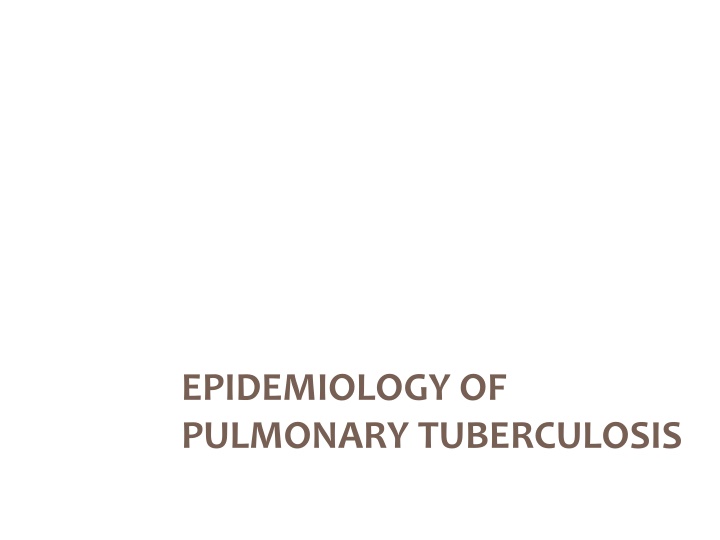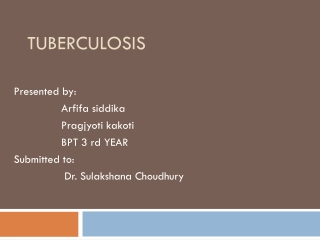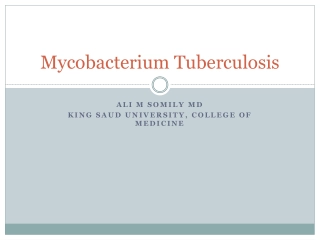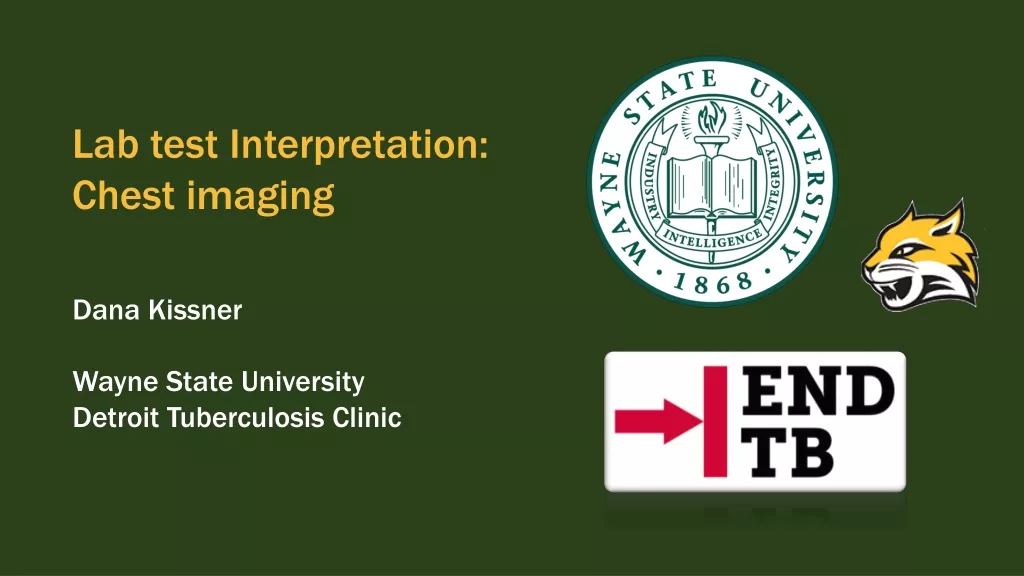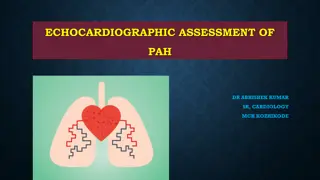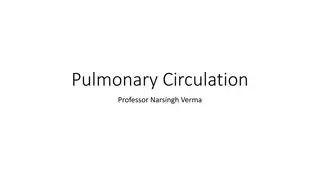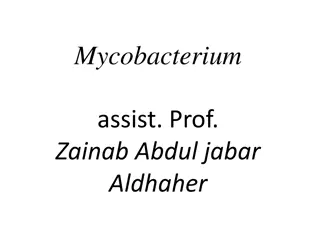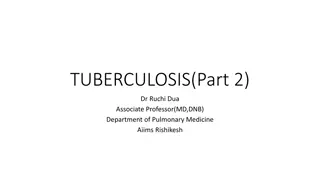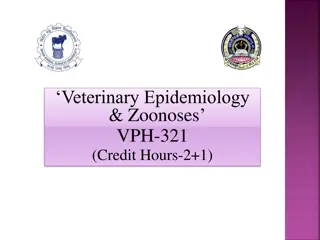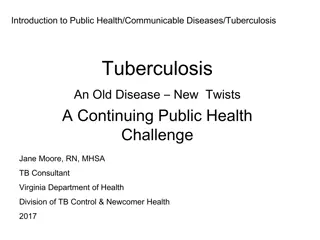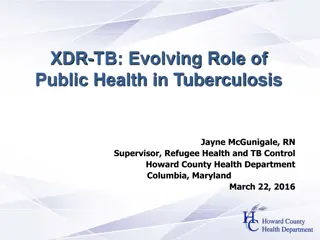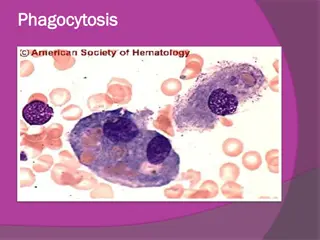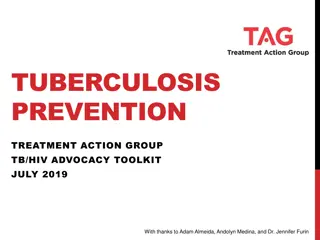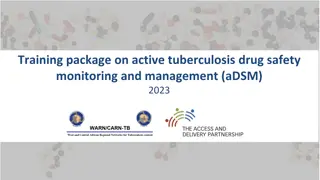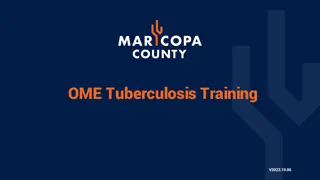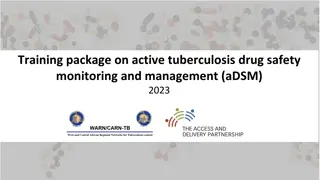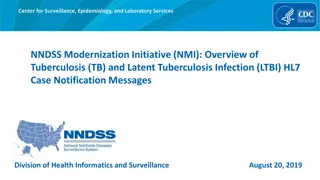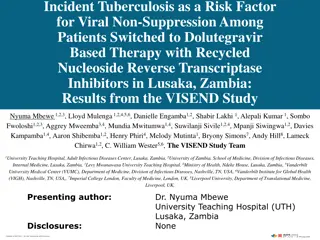Epidemiology of Pulmonary Tuberculosis
Pulmonary tuberculosis is a respiratory tract infection caused by M. Tuberculosis that presents with symptoms like cough, fever, night sweats, and weight loss. Diagnostic criteria, cycle of infection, and measures for prevention and control are crucial in managing this disease. Directly Observed Therapy short course is a key treatment method. Understanding the trend, reasons for resurgence, and at-risk populations are vital in addressing this global health issue.
Download Presentation

Please find below an Image/Link to download the presentation.
The content on the website is provided AS IS for your information and personal use only. It may not be sold, licensed, or shared on other websites without obtaining consent from the author.If you encounter any issues during the download, it is possible that the publisher has removed the file from their server.
You are allowed to download the files provided on this website for personal or commercial use, subject to the condition that they are used lawfully. All files are the property of their respective owners.
The content on the website is provided AS IS for your information and personal use only. It may not be sold, licensed, or shared on other websites without obtaining consent from the author.
E N D
Presentation Transcript
EPIDEMIOLOGY OF PULMONARY TUBERCULOSIS
LEARNIN G OBJECTIVES State the diagnostic criteria of pulmonary tuberculosis Describe trend & state reasons for resurgence of pulmonary tuberculosis List population subgroups at risk of pulmonary tuberculosis Draw the cycle of infection of pulmonary tuberculosis Outline the procedures of diagnosis of pulmonary tuberculosis with emphasis on the limitation of each procedure Describe measures for the prevention and control of pulmonary tuberculosis Describe the Directly Observed Therapy short course for the treatment of pulmonary tuberculosis
PERFORMANCE OBJECTIVE To decide on the best measure(s) for the prevention and control of pulmonary tuberculosis and to prevent its spread to susceptible population
PULMONARY TUBERCULOSIS Respiratory tract infection Caused by M. Tuberculosis
PULMONARY TUBERCULOSIS Suspected cases present with Cough & expectoration for 3 weeks Low grade fever Night sweating Loss of weight
PULMONARY TUBERCULOSIS SMEAR POSITIVE SMEAR NEGATIVE 2 Positive sputum smears OR, 3 Negative sputum smears + Suggestive symptoms + Positive radiology + Decision to treat as TB 1 Positive sputum smear + positive radiology OR, OR, 1 Positive sputum smear + positive culture Culture positive but negative sputum smear
PULMONARY TUBERCULOSIS INFECTION Primary Post primary First exposure Reactivation/re-infection DISEASE Active tuberculosis Latent tuberculosis Disease process No disease yet
PULMONARY TUBERCULOSIS IN SAUDI ARABIA 64,345 reported cases; 48% non-Saudis for 2000 2013 Annual incidence rate (2013) Between 14 to 17 per 100,000 populations Between 8.6 and 12.2 per 100,000 Saudi population
RESURGENCE OF TUBERCULOSIS Deterioration of the living conditions Appearance of strains of M. tuberculosis resistant to anti-tuberculosis drugs. HIV/AIDS pandemic Resurging diseases are Infectious diseases which its incidence has increased in the past two decades or threaten to increase in the near future after a considerable period of decline.
MAJOR RISK FACTORS OF PULMONARY TUBERCULOSIS Social factors: Unfavorable social conditions Pre-pathogenic conditions: HIV/AIDS, diabetes Occupation: Exposure & working conditions Habit: Smoking
PROGRESS Annual slow decline in the rates of tuberculosis An estimated of 37 million lives saved between 2000 and 2013 as a result of effective diagnosis and treatment.
CYCLE OF INFECTION OF PULMONARY TUBERCULOSIS Susceptible host: Low standard of livings, malnutrition, alcoholism, HIV/AIDS Agent: Mycobacterium tuberculosis Portal of entry (inlet): Respiratory tract Incubation period=4-12 weeks Transmission: Contact: Direct, indirect& droplet Air borne: droplet nuclei & dust transmission Reservoir Man in the form of a case Portal of exit: Respiratory tract Source of infection: Sputum and contaminated articles, dust
DIAGNOSIS OF TUBERCULOSIS Non specific symptoms and signs (mimic chest infection) Delay consultation + Delay diagnosis
DIAGNOSIS OF PULMONARY TUBERCULOSIS Tuberculin skin test (Mantoux technique) Chest radiography Microscopic examination of sputum specimen Culture of sputum specimen
TUBERCULIN SKIN TEST 0.1 ml PPD (1) Erythema Edema Induration (2) (3) (4)
TUBERCULIN SKIN TEST Report induration size in mm Induration = Previous exposure to M. protein Size 10 + mm = positive 5 - <10 mm = positive in immune compromised 15 mm = suggestive of infection rather than BCG Induration
Contact of a case Tuberculin negative Tuberculin positive Repeat tuberculin Chest radiography Tuberculin negative Tuberculin positive X-ray negative X-ray positive Chemoprophylaxis BCG vaccine Treatment TUBERCULIN TESTING IN MANAGING CONTACTS
CHEST RADIOGRAPHY Chest radiography findings Enlarged mediastinal LN Consolidation (area of opacity) Cavitations (dark area) Negative (not uncommon)
SPUTUM SMEAR & CULTURE Collection Microscopy Culture
Susceptible host Agent Protection Identify & treat Transmission Reservoir Contact Air borne Minimize exposure PREVENTION AND CONTROL OF RIs
PREVENTION & CONTROL OF RIs Protection of susceptible Identification and treatment Anti-tuberculosis drugs Minimize exposure BCG vaccine: Live attenuated vaccine, 0.1ml IM injection in the left deltoid within 40 days of birth Isolation of case (respiratory precautions) Concurrent disinfection (patients items) Ventilation & exposure to sunlight Cleaning floor with disinfectant Improve nutrition status Increase host resistance Control transmission Eliminate reservoir
DIRECTLY OBSERVED THERAPY SHORT COURSE (DOTS) 4 months 2 months First line medications Initial phase (2 HRZE) Isoniazid (H) Rifampicin (R) Pyrazinamide (Z) Ethambutol (E) Maintenance phase (4 HR) daily or (4 HR)3 (three times per week) Isoniazid (H) Rifampicin (R)
DIRECTLY OBSERVED THERAPY SHORT COURSE (DOTS) Strategy to improve compliance Fixed Dose Combination therapy (FDC) - ALL IN ONE tablet 4 months 2 months First line medications Initial phase (2 HRZE) Isoniazid (H) Rifampicin (R) Pyrazinamide (Z) Ethambutol (E) Maintenance phase (4 HR) daily or (4 HR)3 (three times per week) Isoniazid (H) Rifampicin (R)
